Geekscape Movie Reviews – The Fernando Di Leo Crime Collection
I am an Italian-American, and yet somehow Italian cinema is a blind spot of mine. That’s an embarrassing thing to admit – especially for a film critic – considering the geyser of culture that’s been spewing from Europe’s favorite phallus since the dawn of the Roman Empire. Yup, orgies and vomitoriums led to The Bicycle Thief and La Strada. It almost seems like a stretch when you put it that way. It’s a little easier to swallow the load of genre flicks Italy has dropped on the world from the likes of Dario Argento and Mario Bava, who are well known in the states for their various genre films. But Fernando Di Leo? Who the heck is he?
Independent distributor Raro Video is making a concerted effort to answer that question with their latest release, The Fernando Di Leo Crime Collection. The boxed set includes four of Di Leo’s crime films, including Caliber 9, The Italian Collection and The Boss, which make up his ‘Milieu Trilogy’ – a thematically connected series of films about organized Italian crime. Also tacked onto the set is Rulers of the City, a similar but less melodramatic caper starring Jack Palance. Are these movies the classics that America needs to finally recognize the genius of Fernando Di Leo, or are they just a bunch of neat Italian crime flicks? Let’s find out together, shall we…?
Caliber 9 (aka Milan calibro 9)
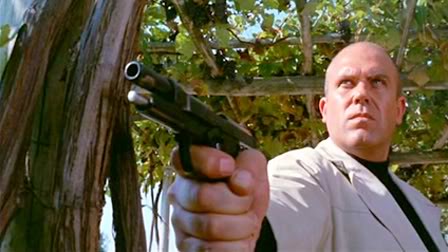
The first film in Di Leo’s Milieu Trilogy stars Italian actor Gaston Moschin (The Godfather, Part II) as Ugo Piazza, a big lug of a guy who gets out of prison and into even deeper trouble. It seems that everyone in Italy thinks Ugo stole $300,000 from the mob and got himself thrown in prison to escape suspicion. If so, it didn’t work… because he’s still the prime suspect. But did Ugo do it? He spends the entire film insisting otherwise to an angry mob (double-meaning, there) but it’s not until the remarkable final act that all is revealed. The film that precedes it is a little less than remarkable, at least in my eyes.
Caliber 9 is a very serious film, full of ponderous talking in rooms and speeches about how the Italian government is responsible for its own problems with crime. It almost feels like an episode of The Wire – in fact, Gaston Moschin looks a hell of a lot like The Wire’s Domenick Lambardozzi, if you’re as distracted by that kind of thing as I am – but it would be a rather slow episode, and the cultural commentary feels less relevant in this day, age and time zone. In Italy, Caliber 9 is apparently regarded as one of Di Leo’s best works… in America, Di Leo’s serious insights into the inner workings of mob and police tactics don’t hit as hard. Without the cultural context necessary to truly grasp the intricacies of Caliber 9, audiences are left with a fairly dry crime thriller that almost wouldn’t be worth watching were it not for, again, a humdinger of a finale. Surprises galore and unexpected character developments make Caliber 9 a satisfying cinematic experience in the end, but for neophytes it won’t be the highlight of this box set.
The Italian Connection (aka La mala ordina)
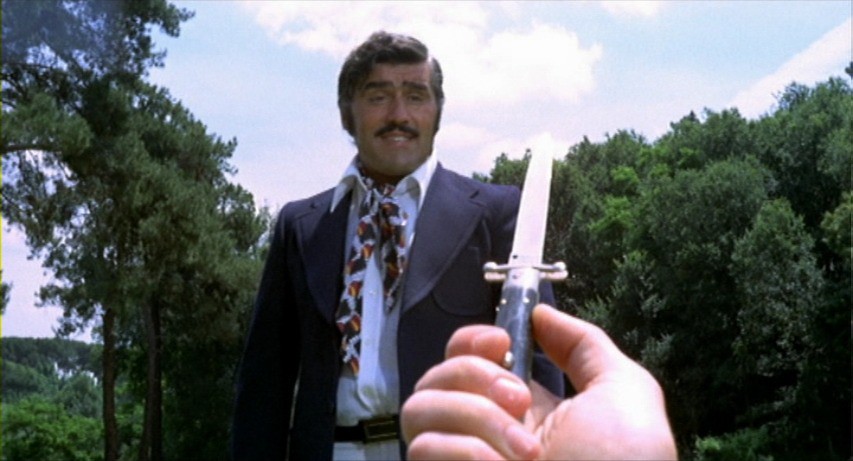
If you’re looking for the highlight of the Fernando Di Leo Crime Collection, this might be it. Mario Adorf graduates from a supporting role in Caliber 9 to the bona fide star of The Italian Connection, or as my friend Michelle calls it, Let’s Kill Luca Carnali. Adorf plays Carnali, a small time pimp and part-time father who gets framed for stealing a million dollars worth of heroin from the American mafia. The Americans send two hitmen to Italy to rub him out and the Italian mob plays along: before the movie’s halfway over, the entire country is out to get Carnali, a poor mope with only luck and a supercharged head butt in his arsenal. They never explain that supercharged head butt, but it’s a recurring theme. He uses his forehead to destroy telephones and break through windshields, and nobody ever gives it a second thought. I guess it’s just Luca Carnali’s ‘thing.’
Adorf owns this movie. He’s lovable but still plausible as a professional criminal, and he resists the urge to transform over the course of the film into an action hero. He’s just a poor, overweight bastard, and for most of the film he doesn’t even know why everyone wants to kill him. That’s what upsets him the most, honestly… that the whole world turned without sending him the memo. That’s not to say that The Italian Connection is a whiny affair: after a first act that for no particular reason focuses entirely on the American hitmen (played by Henry Silva and Woody Strode), the action picks up considerably as soon as Carnali takes center stage. The highlight of the film is one of the most breathless car chases I’ve ever witnessed, and I’m a professional witnesser of car chases over here. The Italian Connection is an excellent, entertaining film, and highly recommended.
The Boss (aka Il Boss, aka Wipeout!)
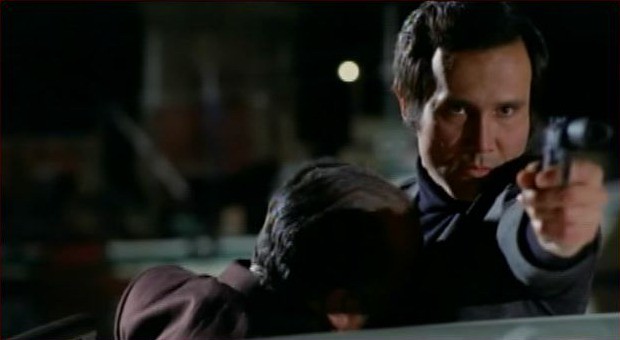
Di Leo’s Milieu Trilogy concludes with The Boss, the most action-oriented of the series. Like Adorf before him, Henry Silva goes from supporting character to leading man here. He plays Nick Lanzetta, a Sicilian mobster who at the start of the film kills an entire rival mafia family with a bazooka while they’re in a movie theater watching porn. That’s a hell of a way to start a film. The Boss slows down a bit after that, focusing on the retaliation for Nick’s crazy stunt. Nick’s boss’s daughter is kidnapped and Nick’s responsible for getting her back. The problem is that she doesn’t want to go back… she’s been gangbanging her captors nonstop since they nabbed her.
Aw yeah… The Boss ain’t a subtle film, but it moves like a freight train loaded with nitroglycerin and that’s not a bad thing. The film is a series of retaliations, one after the other: Nick kills rival mobsters, rival mobsters kidnap his boss’s daughter, Nick kills a bunch of people to get her back, they retaliate again, and so on. Miraculously this sequence of events never feels repetitive. The film slows down every so often, occasionally to its detriment, but overall the domino effect is exhilarating. The sequence of events is equally unexpected and inevitable, and Silva gives the best performance I’ve ever seen from the actor (whom you may recognize from the original Manchurian Candidate and Above the Law). It’s a tricky thing, being a complete bastard but also a likable protagonist, and Silva never attempts to appeal to the audience’s sympathies. He earns our respect, not our love, and that’s enough for us to want him to succeed even when he acts like a total douchebag. The Boss is a fantastic film, less emotionally involving than The Italian Connection, but just as highly recommended.
Rulers of the City (aka Mr. Scarface, aka I pardoni della citta)
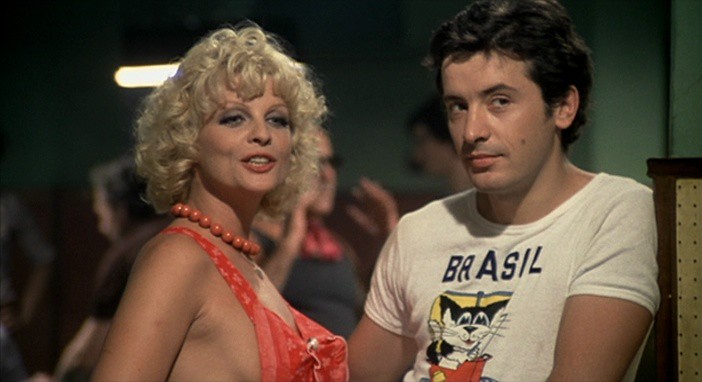
More scattershot than the other films in this set, and only tangentially related, is Rulers of the City, better known in America as Mr. Scarface. The film stars Harry Baer as Tony, the spindliest loan collector ever hired by the mafia. He makes up for it in an early scene when he proves his craftiness by kickboxing the crap out of a much bigger guy during the course of his daily rounds. Unfortunately, Tony’s experience with crap earns him the crappiest assignment imaginable when he’s asked to collect on a bad check from the feared mobster ‘Mr. Scarface,’ played by future Academy Award-winner Jack Palance (City Slickers). Tony and his cohort Rick (Al Cliver) manage to con Mr. Scarface out of three times the amount of money he owes and then they pocket the change, but when their plot is discovered they have to take on both crime families using only their wits against two whole armies of guns and muscle.
It’s a great idea for a movie, but Rulers of the City never quite mounts its throne. It takes a long time to set up the storyline, and it’s difficult to determine who exactly is the star of the film after a confusing prologue about one of the protagonists as a young boy. When the film cuts directly to an adult years later, the audience naturally assumes that it must be the same kid from the flashback, but that’s not necessarily the case making it hard to latch onto exactly what’s happening and how it connects to the first scene, and not in a good ‘Hmm… How Interesting’ kind of way. Tony and Rick’s plots to take on the mob are indeed clever, or at least gutsy as hell, but the climactic shootout loses steam quickly. They dispatch their main antagonist at the start of the action sequence and then spend what feels like fifteen minutes dispatching a horde of nameless underlings. It’s thrillingly choreographed, with motorcycle chases, explosions and cleverly staged gunfights, but all of our emotional investment is spent before it gets going. Rulers of the City isn’t a great film, but as a bonus feature to the superior Milieu Trilogy it’s a nice addition to the set.
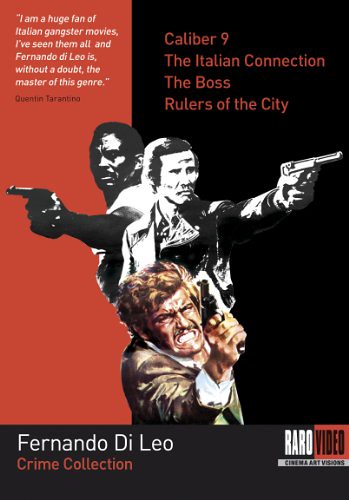
Bonus Features on films like these are often scarce, but each film comes with a fairly in-depth documentary about the production. These docs are all Italian and subtitled, but full of interesting and occasionally even unwanted information. (Harry Baer had hemorrhoids while shooting Rulers of the City, which puts his elaborate stuntwork into unnecessary perspective.) The set also comes with a classy, Criterion-style booklet containing a brief essay on Di Leo’s work and a thorough interview with the director about his many projects. It’s a Must-Read if you liked any of the films in this set. Di Leo is an honest man, and amusingly self-aggrandizing. (He says he’s a better director than Don Siegel. That’s a stretch if you ask me.)
The picture and sound presentation is excellent throughout the set, particularly given the usual lack of love for films of this ilk. English Language and Italian tracks are both available, which is damned respectful of Raro Video. But The Fernando Di Leo Crime Collection is not without problems: there’s a brief but severe attack of image instability in Il Boss, as well as a curious bit in that same film where the English language track turns Italian for a couple minutes for no discernable reason. Worst of all is the fact that Rulers of the City has a non-anamorphic transfer. It looks just fine when blown up to full size using your HDTV’s ‘Zoom’ function, but considering that the rest of the films are given the full anamorphic treatment it’s a perplexing issue.
Is The Fernando Di Leo Crime Collection a revelation? That’s a stretch, but it’s an illuminating look at the work of a talented genre director who doesn’t get much love across the Atlantic. Quentin Tarantino sure seems to like him – the American hitmen from The Italian Connection are clear inspirations for John Travolta and Samuel L. Jackson’s hitmen from Pulp Fiction – but don’t approach this box set for some kind of creative epiphany. These are just excellent pulpy diversions, The Italian Connection and The Boss in particular, and worth buying for any B-Movie, Italian Cinema, Action or Grindhouse enthusiasts.
